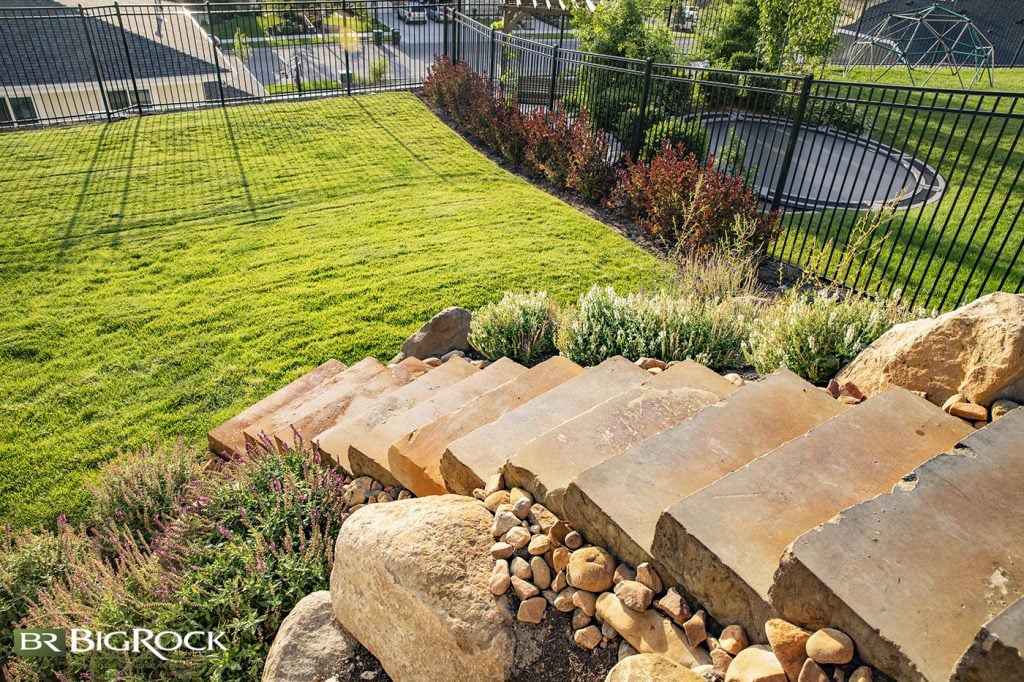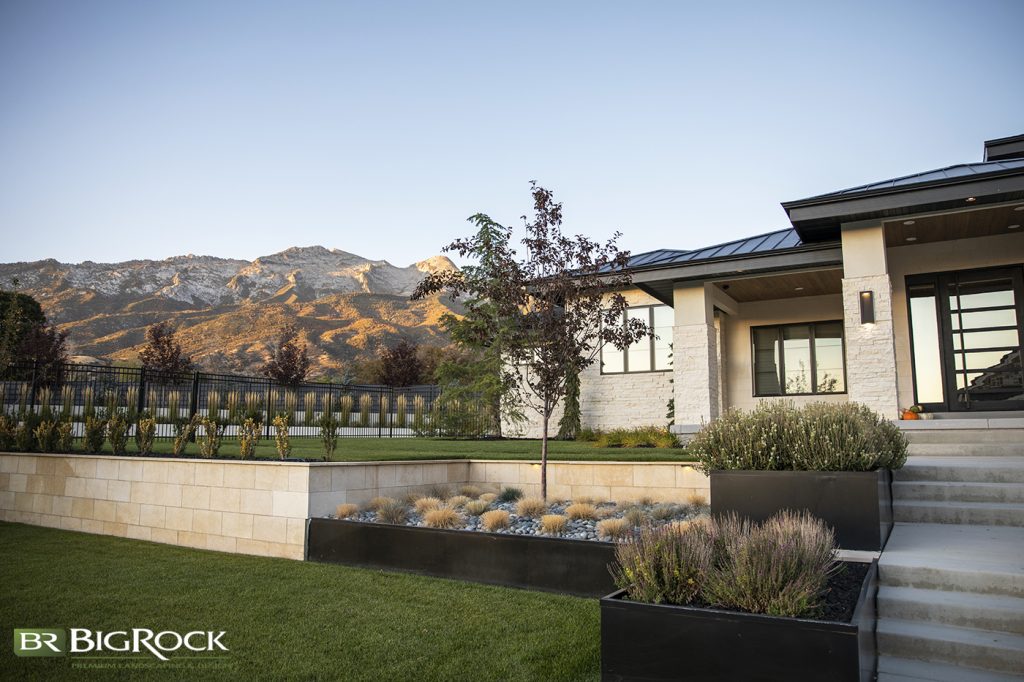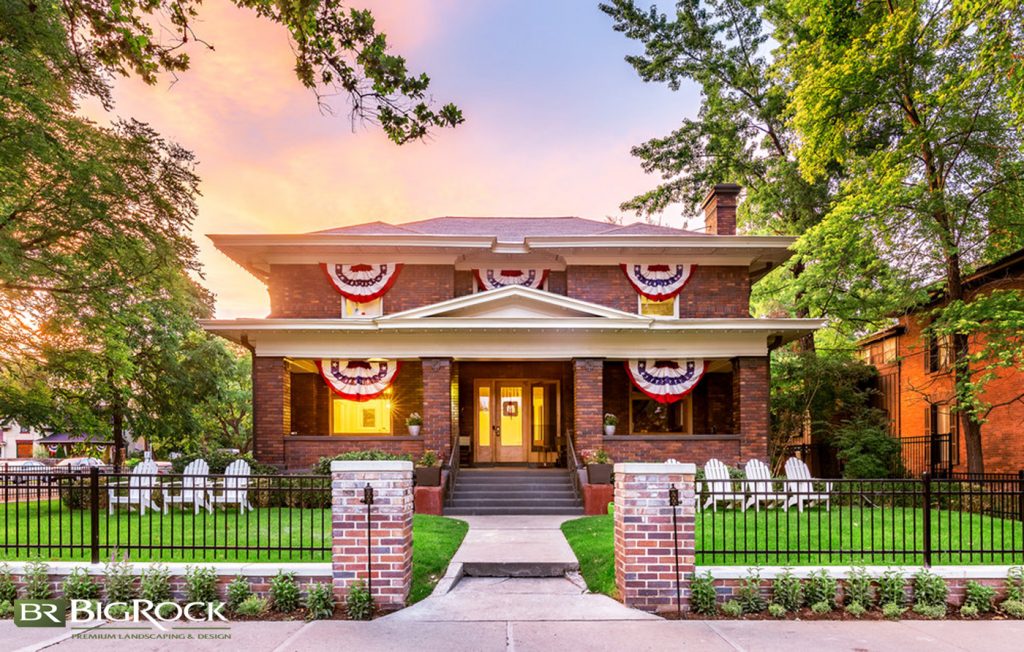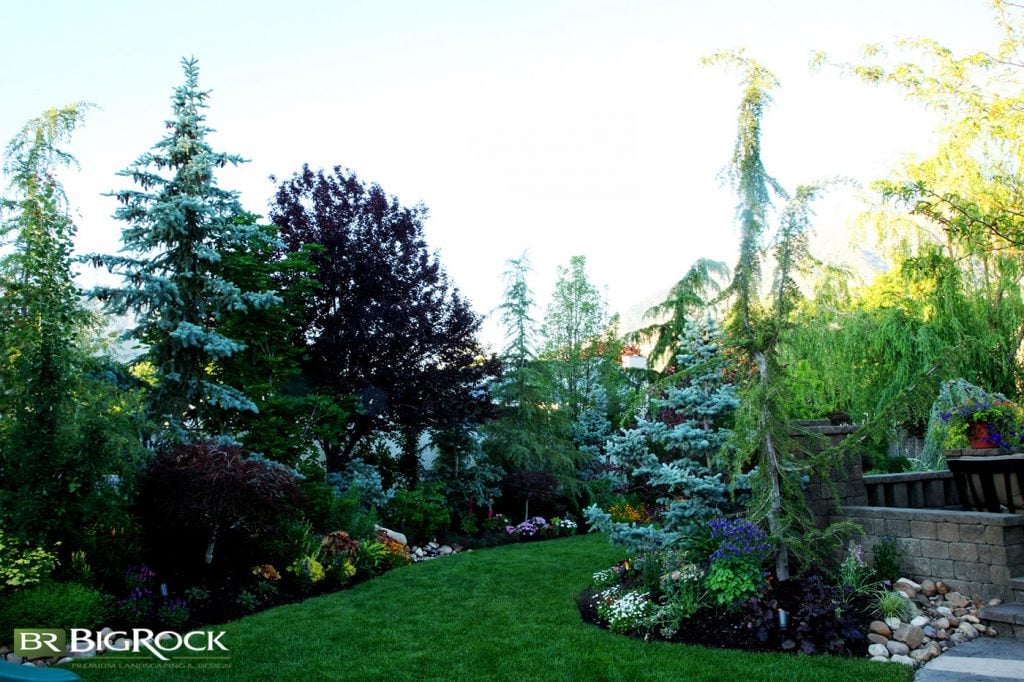If you are a Utah homeowner, you have probably considered the benefits of xeriscaping your yard at one point or another. Maybe you don’t like the huge water bill, or you want to help conserve water. But many families enjoy the benefits of a lawn, and while xeriscaping is a beautiful option, if you don’t love the look or you prefer grass, there are ways to be smart with your water usage and still enjoy a green lawn. Our team at Big Rock Landscaping believes that there is a balance between xeriscaping and blindly wasting water, especially for homeowners who are willing to follow some simple guidelines to ensure their water usage is as efficient as possible. This is your guide to using your water efficiently in your yard to help keep your grass, trees and shrubs green and full all summer long without overusing water.
Watering Guide For Your Utah Lawn
Whether this is your first summer as a homeowner in Utah or your 30th, you likely know by now that the summers here are hot and dry—difficult conditions for a lawn to thrive without a little TLC. And that’s what lawn care in Utah comes down to- how much time and effort do you want to spend on growing lush, green grass? If you have the time, resources, and desire to keep your lawn looking great all summer, it’s totally possible, even in Utah’s climate. That being said, there are lots of beautiful options for xeriscaping that don’t require the care that lawns do. If you’re ready to keep your lawn looking green and healthy, we have all the steps you need to make sure it thrives in the summer heat.

Here’s your guide to a stunning Utah lawn:
- Invest in a smart sprinkler. These sprinklers track the weather in your area to avoid sprinkling during rain or wind. They are also equipped with ET (evapotranspiration) sensors that monitor the evaporation from the soil. These features help the smart sprinkler make real-time adjustments to your watering schedule based on the lawn’s actual needs. If you want a smart sprinkler system but you don’t love the cost, Utah has a rebate program to help you buy your smart sprinkler.
- Do a yearly “background check” on your system. You might be surprised at the gaps you find in your watering schedule or even the sprinkler’s actual path over your yard. Ask yourself the following questions about each zone:
- Are all the sprinklers in this area pointing towards the grass?
- Are all the sprinklers in working condition? Check for broken sprinkler heads, valves, and controllers and replace or repair the broken parts.
- Have you set up your zones based on their shade or lack thereof? The shady areas of your yard will need less than the unshaded areas.
- Are you using the correct nozzles and heads?
- Are your drip emitter heads working properly in your garden beds?
If you still aren’t sure about how much water your lawn is getting, put several containers throughout your yard, turn your sprinklers on and check to see how much water is in the containers after 10, 20, and 30 minutes. You want to get between ½ and ¾ an inch per zone per watering (for a total of 2 ½ to 3 inches total per week in the summer). Watch to see how long it takes to fill the containers to ½ an inch and then adjust your watering schedule- you might find that some zones fill quickly (this might be because of the style of sprinkler head you are using—fan sprinklers need less time than a rotary style sprinkler) or don’t fill at all. This is a great test to figure out the best direction for your sprinkling system.
- Once you’ve completed your sprinkler background check, ensure your system is set to run based on your findings. Regularly check to make sure that all the areas of your lawn are getting the amount of water.
- Water in the early morning- this allows the grass to soak enough of the water before it gets too hot, but it also ensures that the water doesn’t sit on the grass during the night which can cause fungal growth in the lawn.
- Leave your lawn a little longer, this helps retain water and will help the grass from drying out.
- Watch for early signs of a dry lawn:
- Visible footprints after you walk across it—dry grass will lay flat while healthy grass will pop back up to its previous state.
- Grass blades will fold in on the center line and look thin, healthy grass will stay open and be wide and flat.
- The grass will have a bluish/gray color instead of a vibrant green.
Each yard is different, so it might take some trial and error to figure out the best routine and system for your space, but a bright, comfortable lawn is worth the effort. Or, if you want a green lawn but you don’t want the effort, our team of expert landscapers can help care for your yard so you don’t have to!

Watering Guide For Your Utah Trees
Utah’s trees are a valuable part of the state’s landscape and environment, especially during a drought. But not all tree species, ages, and environments are the same, making trees one of the more difficult landscape elements to give hard and fast care-taking rules. We have some general guidelines to help you keep your tree watered throughout the summer, but if you aren’t sure what the best practices are for your specific trees, we can help! Here are our guidelines for tree watering in Utah:
- Check the soil of your tree to find out how much water it needs. Dig between 4-6 inches down and check the soil- is it crumbly and dry? Is it soggy and mushy? Or is it nicely damp without being soaked? You’re looking for damp soil that isn’t overly soaked.
- Water deeply with a drip system. Trees like consistent, deep watering rather than a light spray every day. In fact, shallow watering will lead to shallow roots, which is not healthy for a tree. By watering deeply you train the roots to grow down into the ground, helping the tree become better established and better able to endure the extreme weather conditions in Utah.
- Check for signs of underwatering- wilting leaves, leaves curling at the edges, a sparse canopy with small leaves, premature fall color, or an early drop of leaves.
- Check for signs of overwatering- algae or mushroom blooms in the soil, leaves that look healthy but break easily and feel brittle, young leaves that turn green or yellow, or new growth that withers before it fully matures.
- Add three to five inches of mulch around the base of the tree to help regulate the tree temperature as well as lock in moisture to the ground.
- New trees will need significantly more water than established trees. When you purchase your new tree, either ask the nursery or consult the tag on the tree to know how much and how often to water. Generally speaking a tree with a diameter of less than four inches (measure about six inches above the ground) should be watered with the same number of inches in gallons. For example, a tree with a diameter of three inches should be watered with 3 gallons. Then check the soil and add up to a gallon more depending on the soil’s dryness.
- Remember to water during the winter, fall and spring months when the weather gets above 40 degrees and there is no snow cover. As always, check the soil to see how dry or wet it is to make sure you aren’t over or under watering.
Remember, all trees and their positions in your landscape are different. It will take time and effort to truly understand the needs of each tree in your yard, especially when you add in the complicating factors of Utah’s extreme weather.

Watering Guide For Your Utah Plants and Shrubs
Shrubs and plants in Utah are diverse and have all kinds of specific needs based on the type and location of the plant. But generally speaking, plants and shrubs are similar to trees in that they love a long, deep soak to help establish a strong root system. More often than not, a shrub will do better when it is watered once, maybe twice a week with a drip system that thoroughly saturates the soil. Here are some tips for watering shrubs and plants in Utah:
- Choose plants that work for your landscape. That means choosing shade loving plants (like hostas, lily of the valley or hellebore) for your shady areas and sun loving plants for sunny spots (think cacti, succulents, black eyed susan or sunflowers).
- Check your soil often. Dig between 4-6 inches down and see if the soil is soggy, dry or moist. You want soil that is damp but not soaking as too much water can cause disease.
- Check for signs of overwatering or underwatering. Overwatered plants and shrubs will have yellowing leaves or brown spots on the leaves. They may also struggle to grow or not grow at all. Underwatered shrubs and plants will be brittle, appear dry, and have stunted growth.
- Add mulch to the area around the shrub or plant. Mulch helps lock moisture in the soil as well as regulate the plant’s temperature. Make sure to add enough mulch around the plant that the root system is also covered by mulch.
DISCOVER: Don’t Panic! Here’s How To Prepare Your Yard For Drought
Your Watering Guide Checklist
There’s a lot to cover when it comes to watering all the greenery in your yard, each space and landscape are different and have different needs. But regardless of your landscape, there are some basic guidelines you should follow no matter what you are watering.
- Know your yard! Pay attention to where the sun hits the yard throughout the year. Notice which spots are covered by shade and which are usually in the sun. Pay attention to your neighbors yard- does their tree overlap into your yard, giving shade to some areas? Do their sprinklers spray into your yard? Consider how your yard reacts to a rainstorm- where does the water pool, where does it run? Good yard care is simply paying attention and then making adjustments based on your observations.
- Buy a smart sprinkler. A lot of the trial and error that comes with yard care, specifically lawn care, can be alleviated with a smart sprinkler.
- Do a yearly check up—look at all your sprinklers and make sure they are working properly and pointed in the right direction. Do a container test and see how much water each area of your yard is actually receiving. Walk around your yard and note what plants and shrubs are struggling then check the soil and sun for that plant. Check your trees- how is the soil around the base? Are there any signs of over or under watering for the tree?
- Remember that even if you see some signs of under watering it might not be cause for concern. Many plants in Utah might wilt during the hottest part of the day and then perk up as the temperature drops in the evening. Some homeowners see a wilting plant, panic and overwater the plant, leading to disease.

Big Rock Landscaping: Your Landscaping Experts
Many Utahns want the beauty of a green lawn, but when it’s actually time to care for the lawn they are overwhelmed or too busy to dedicate their time to maintaining a lawn and landscape. It makes sense—there are so many small details to pay attention to, and it’s even more overwhelming when your landscape hasn’t been planned well. Poor landscape planning can set you up for failure from the beginning- shade in the wrong places or lack of drainage can make it difficult to maintain your yard, even when you are spending hours trying to make it look great.
That’s where the expertise of the design team at Big Rock Landscaping comes in. Our team of dedicated professionals have a combined decades of experience creating all kinds of landscape designs; we’ve designed everything from a lush English garden to a modern xeriscape landscape on a hill. We use our finely tuned process to make sure every detail is covered and you have a full scope of the work from planning to completion. Whether your yard is complete and you need a team of experienced landscaping professionals to maintain the yard or you are starting from scratch to plan the yard of your dreams, Big Rock Landscaping is Utah’s premier landscaping company and the best choice for your yard. Call us today and find out how we can make your yard drought friendly, with or without grass!

